
Illustrative Math Alignment: Grade 6 Unit 1
Dividing Fractions
Lesson 16: Solving Problems Involving Fractions
Use the following Media4Math resources with this Illustrative Math lesson.
| Thumbnail Image | Title | Body | Curriculum Nodes |
|---|---|---|---|

|
Collections in a Box: Fractions | This cheat sheet gathers together a number of resources on the topic of fractions. See the descriptions and links below. Each link takes you to a collection of resources around that topic. The middle column indicates the number of resources available and the third column takes you to page on Media4Math where those resources can be found. Subscribers can download the PDF version of this cheat sheet. Click Preview to see the HTML version. |
Add and Subtract Fractions, Add and Subtract Mixed Numbers, Compare and Order Fractions, Find Equivalent Fractions, Fractions and Mixed Numbers, Relate Fractions to Decimals and Write Fractions in Lowest Terms |
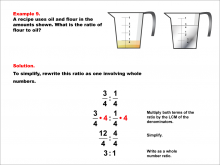
|
Math Example--Ratios and Rates--Ratios with Fractions--Example 9 | Ratios with Fractions--Example 9TopicRatios and Fractions DescriptionIn many scenarios, ratios are expressed using whole numbers, yet there are instances, like in recipes, where fractions play a significant role. This example illustrates a ratio involving fractions and demonstrates how to convert it into a ratio with whole numbers. Students will engage in understanding the process of converting these fractions to whole numbers, enhancing their comprehension of ratios and their practical applications such as cooking or mixing. The focus is on the fundamental skill of fraction conversion and applying it in a ratio context. |
Ratios and Rates |
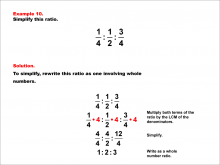
|
Math Example--Ratios and Rates--Ratios with Fractions--Example 10 | +Ratios with Fractions--Example 10TopicRatios and Fractions DescriptionIn many scenarios, ratios are expressed using whole numbers, yet there are instances, like in recipes, where fractions play a significant role. This example illustrates a ratio involving fractions and demonstrates how to convert it into a ratio with whole numbers. Students will engage in understanding the process of converting these fractions to whole numbers, enhancing their comprehension of ratios and their practical applications such as cooking or mixing. The focus is on the fundamental skill of fraction conversion and applying it in a ratio context. |
Ratios and Rates |
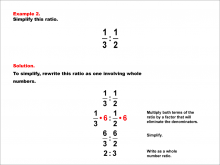
|
Math Example--Ratios and Rates--Ratios with Fractions--Example 2 | Ratios with Fractions--Example 2TopicRatios and Fractions DescriptionIn many scenarios, ratios are expressed using whole numbers, yet there are instances, like in recipes, where fractions play a significant role. This example illustrates a ratio involving fractions and demonstrates how to convert it into a ratio with whole numbers. Students will engage in understanding the process of converting these fractions to whole numbers, enhancing their comprehension of ratios and their practical applications such as cooking or mixing. The focus is on the fundamental skill of fraction conversion and applying it in a ratio context. |
Ratios and Rates |
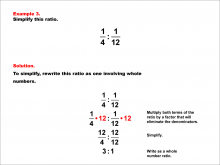
|
Math Example--Ratios and Rates--Ratios with Fractions--Example 3 | Ratios with Fractions--Example 3TopicRatios and Fractions DescriptionIn many scenarios, ratios are expressed using whole numbers, yet there are instances, like in recipes, where fractions play a significant role. This example illustrates a ratio involving fractions and demonstrates how to convert it into a ratio with whole numbers. Students will engage in understanding the process of converting these fractions to whole numbers, enhancing their comprehension of ratios and their practical applications such as cooking or mixing. The focus is on the fundamental skill of fraction conversion and applying it in a ratio context. |
Ratios and Rates |
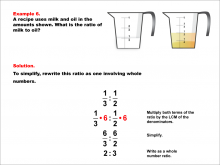
|
Math Example--Ratios and Rates--Ratios with Fractions--Example 6 | Ratios with Fractions--Example 6TopicRatios and Fractions DescriptionIn many scenarios, ratios are expressed using whole numbers, yet there are instances, like in recipes, where fractions play a significant role. This example illustrates a ratio involving fractions and demonstrates how to convert it into a ratio with whole numbers. Students will engage in understanding the process of converting these fractions to whole numbers, enhancing their comprehension of ratios and their practical applications such as cooking or mixing. The focus is on the fundamental skill of fraction conversion and applying it in a ratio context. |
Ratios and Rates |
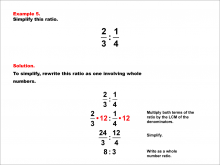
|
Math Example--Ratios and Rates--Ratios with Fractions--Example 5 | Ratios with Fractions--Example 5TopicRatios and Fractions DescriptionIn many scenarios, ratios are expressed using whole numbers, yet there are instances, like in recipes, where fractions play a significant role. This example illustrates a ratio involving fractions and demonstrates how to convert it into a ratio with whole numbers. Students will engage in understanding the process of converting these fractions to whole numbers, enhancing their comprehension of ratios and their practical applications such as cooking or mixing. The focus is on the fundamental skill of fraction conversion and applying it in a ratio context. |
Ratios and Rates |
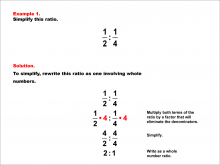
|
Math Example--Ratios and Rates--Ratios with Fractions--Example 1 | Ratios with Fractions--Example 1TopicRatios and Fractions DescriptionIn many scenarios, ratios are expressed using whole numbers, yet there are instances, like in recipes, where fractions play a significant role. This example illustrates a ratio involving fractions and demonstrates how to convert it into a ratio with whole numbers. Students will engage in understanding the process of converting these fractions to whole numbers, enhancing their comprehension of ratios and their practical applications such as cooking or mixing. The focus is on the fundamental skill of fraction conversion and applying it in a ratio context. |
Ratios and Rates |
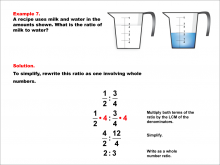
|
Math Example--Ratios and Rates--Ratios with Fractions--Example 7 | Ratios with Fractions--Example 7TopicRatios and Fractions DescriptionIn many scenarios, ratios are expressed using whole numbers, yet there are instances, like in recipes, where fractions play a significant role. This example illustrates a ratio involving fractions and demonstrates how to convert it into a ratio with whole numbers. Students will engage in understanding the process of converting these fractions to whole numbers, enhancing their comprehension of ratios and their practical applications such as cooking or mixing. The focus is on the fundamental skill of fraction conversion and applying it in a ratio context. |
Ratios and Rates |
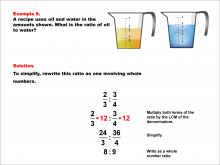
|
Math Example--Ratios and Rates--Ratios with Fractions--Example 8 | Ratios with Fractions--Example 8TopicRatios and Fractions DescriptionIn many scenarios, ratios are expressed using whole numbers, yet there are instances, like in recipes, where fractions play a significant role. This example illustrates a ratio involving fractions and demonstrates how to convert it into a ratio with whole numbers. Students will engage in understanding the process of converting these fractions to whole numbers, enhancing their comprehension of ratios and their practical applications such as cooking or mixing. The focus is on the fundamental skill of fraction conversion and applying it in a ratio context. |
Ratios and Rates |
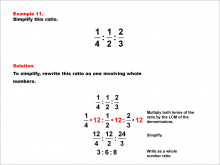
|
Math Example--Ratios and Rates--Ratios with Fractions--Example 11 | Ratios with Fractions--Example 11TopicRatios and Fractions DescriptionIn many scenarios, ratios are expressed using whole numbers, yet there are instances, like in recipes, where fractions play a significant role. This example illustrates a ratio involving fractions and demonstrates how to convert it into a ratio with whole numbers. Students will engage in understanding the process of converting these fractions to whole numbers, enhancing their comprehension of ratios and their practical applications such as cooking or mixing. The focus is on the fundamental skill of fraction conversion and applying it in a ratio context. |
Ratios and Rates |
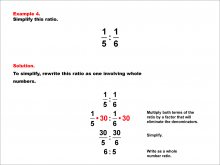
|
Math Example--Ratios and Rates--Ratios with Fractions--Example 4 | Ratios with Fractions--Example 4TopicRatios and Fractions DescriptionIn many scenarios, ratios are expressed using whole numbers, yet there are instances, like in recipes, where fractions play a significant role. This example illustrates a ratio involving fractions and demonstrates how to convert it into a ratio with whole numbers. Students will engage in understanding the process of converting these fractions to whole numbers, enhancing their comprehension of ratios and their practical applications such as cooking or mixing. The focus is on the fundamental skill of fraction conversion and applying it in a ratio context. |
Ratios and Rates |
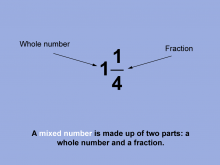
|
Math Clip Art--Fraction Concepts--Mixed Numbers 02 | Math Clip Art--Fraction Concepts--Mixed Numbers 02TopicFractions DescriptionThis image presents the mixed number 1 1/4 with the whole number part labeled and the fraction part clearly identified. It shows the number 1 1/4 with arrows or labels pointing to the '1' as the whole number part and '1/4' as the fraction part. This representation helps students understand the structure of mixed numbers, showing how they combine a whole number with a proper fraction. It provides a clear visual breakdown of the components of a mixed number. |
Fractions and Mixed Numbers |
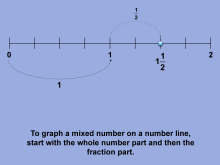
|
Math Clip Art--Fraction Concepts--Mixed Numbers 04 | Math Clip Art--Fraction Concepts--Mixed Numbers 04TopicFractions DescriptionThis image is a variation of the previous one, for 1 1/2, showing the whole number part on the number line and then the fractional part. It displays a number line with the whole number 1 clearly marked, and then shows how the additional 1/2 is added to reach the final position of 1 1/2. This representation helps students understand how mixed numbers are constructed on a number line, breaking down the process into two steps: locating the whole number, then adding the fraction. It reinforces the concept that mixed numbers combine whole numbers and fractions. |
Fractions and Mixed Numbers |
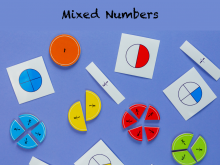
|
Math Clip Art--Fraction Concepts--Mixed Numbers 01 | Math Clip Art--Fraction Concepts--Mixed Numbers 01TopicFractions DescriptionThis image serves as the title card for a series on mixed numbers. It displays the text "Mixed Numbers" in a clear, prominent font. The background may include subtle mathematical elements or fraction-related graphics to set the context for the following images in the series. This introductory image sets the stage for the subsequent images, preparing students for an exploration of mixed numbers, which combine whole numbers and fractions. It provides a clear, concise title that immediately informs viewers about the specific fraction concepts they'll be studying. |
Fractions and Mixed Numbers |
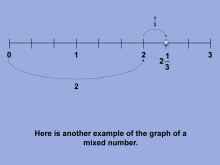
|
Math Clip Art--Fraction Concepts--Mixed Numbers 05 | Math Clip Art--Fraction Concepts--Mixed Numbers 05TopicFractions DescriptionThis image presents a variation with 2 1/3 graphed on the number line. It shows a number line with whole numbers marked, and a point clearly indicated at 2 1/3, which would be one-third of the way from 2 to 3. This representation builds on the previous examples, helping students visualize a different mixed number on the number line. It reinforces the concept that mixed numbers can be located precisely between whole numbers and helps students understand how the fractional part determines the exact position. |
Fractions and Mixed Numbers |
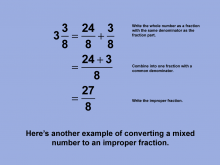
|
Math Clip Art--Fraction Concepts--Mixed Numbers 11 | Math Clip Art--Fraction Concepts--Mixed Numbers 11TopicFractions DescriptionThis image shows a variation of the previous concept, now converting 3 3/8 to 27/8. It displays the step-by-step process of multiplying 3 by 8 to get 24, adding 3, and then writing 27 over 8. This representation builds on the previous example, helping students see how the process works with larger mixed numbers. It reinforces the concept that the numerator of the resulting improper fraction will always be larger than the denominator when converting from a mixed number. |
Fractions and Mixed Numbers |

|
Math Clip Art--Fraction Concepts--Mixed Numbers 02 | Math Clip Art--Fraction Concepts--Mixed Numbers 02TopicFractions DescriptionThis image presents the mixed number 1 1/4 with the whole number part labeled and the fraction part clearly identified. It shows the number 1 1/4 with arrows or labels pointing to the '1' as the whole number part and '1/4' as the fraction part. This representation helps students understand the structure of mixed numbers, showing how they combine a whole number with a proper fraction. It provides a clear visual breakdown of the components of a mixed number. |
Fractions and Mixed Numbers |

|
Math Clip Art--Fraction Concepts--Mixed Numbers 05 | Math Clip Art--Fraction Concepts--Mixed Numbers 05TopicFractions DescriptionThis image presents a variation with 2 1/3 graphed on the number line. It shows a number line with whole numbers marked, and a point clearly indicated at 2 1/3, which would be one-third of the way from 2 to 3. This representation builds on the previous examples, helping students visualize a different mixed number on the number line. It reinforces the concept that mixed numbers can be located precisely between whole numbers and helps students understand how the fractional part determines the exact position. |
Fractions and Mixed Numbers |
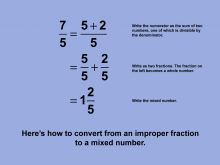
|
Math Clip Art--Fraction Concepts--Mixed Numbers 07 | Math Clip Art--Fraction Concepts--Mixed Numbers 07TopicFractions DescriptionThis image shows the numerical manipulation of 7/5 and converting it to 1 2/5. It displays the step-by-step process of dividing 7 by 5 to get 1 with a remainder of 2, which then becomes the numerator of the fractional part. This representation helps students understand the mathematical process behind converting improper fractions to mixed numbers. It provides a clear, numerical approach to complement the visual models seen in previous images. Teachers can use this image to explain the algorithm for converting improper fractions to mixed numbers and to reinforce the connection between division and fractions. |
Fractions and Mixed Numbers |
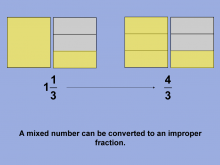
|
Math Clip Art--Fraction Concepts--Mixed Numbers 09 | Math Clip Art--Fraction Concepts--Mixed Numbers 09TopicFractions DescriptionThis image shows rectangular models demonstrating how 1 1/3 can be converted to 4/3, illustrating that a mixed number can also be written as an improper fraction. It displays one whole rectangle plus a third of another rectangle, alongside a model showing four thirds. This representation helps students visualize the process of converting mixed numbers to improper fractions. It reinforces the idea that mixed numbers and improper fractions can represent the same quantity. |
Fractions and Mixed Numbers |

|
Math Clip Art--Fraction Concepts--Mixed Numbers 11 | Math Clip Art--Fraction Concepts--Mixed Numbers 11TopicFractions DescriptionThis image shows a variation of the previous concept, now converting 3 3/8 to 27/8. It displays the step-by-step process of multiplying 3 by 8 to get 24, adding 3, and then writing 27 over 8. This representation builds on the previous example, helping students see how the process works with larger mixed numbers. It reinforces the concept that the numerator of the resulting improper fraction will always be larger than the denominator when converting from a mixed number. |
Fractions and Mixed Numbers |

|
Math Clip Art--Fraction Concepts--Mixed Numbers 09 | Math Clip Art--Fraction Concepts--Mixed Numbers 09TopicFractions DescriptionThis image shows rectangular models demonstrating how 1 1/3 can be converted to 4/3, illustrating that a mixed number can also be written as an improper fraction. It displays one whole rectangle plus a third of another rectangle, alongside a model showing four thirds. This representation helps students visualize the process of converting mixed numbers to improper fractions. It reinforces the idea that mixed numbers and improper fractions can represent the same quantity. |
Fractions and Mixed Numbers |

|
Math Clip Art--Fraction Concepts--Mixed Numbers 10 | Math Clip Art--Fraction Concepts--Mixed Numbers 10TopicFractions DescriptionThis image shows the numerical manipulation of converting 1 2/5 to 7/5. It displays the step-by-step process of multiplying the whole number by the denominator, adding the numerator, and then writing this over the original denominator. This representation helps students understand the mathematical process behind converting mixed numbers to improper fractions. It provides a clear, numerical approach to complement the visual models seen in previous images. Teachers can use this image to explain the algorithm for converting mixed numbers to improper fractions and to reinforce the connection between multiplication and fractions. |
Fractions and Mixed Numbers |
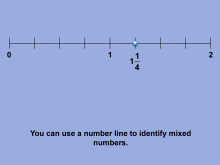
|
Math Clip Art--Fraction Concepts--Mixed Numbers 03 | Math Clip Art--Fraction Concepts--Mixed Numbers 03TopicFractions DescriptionThis image shows the graph of 1 1/4 on a number line. It displays a number line with whole numbers marked, and a point clearly indicated at 1 1/4, which would be halfway between 1 and 1 1/2. This representation helps students visualize where mixed numbers fall on a number line, reinforcing their understanding of how mixed numbers relate to whole numbers and fractions. It provides a concrete way to see that 1 1/4 is more than 1 but less than 2. Teachers can use this image to discuss how mixed numbers can be located on a number line and to reinforce the concept that mixed numbers represent values between whole numbers. |
Fractions and Mixed Numbers |

|
Math Clip Art--Fraction Concepts--Mixed Numbers 04 | Math Clip Art--Fraction Concepts--Mixed Numbers 04TopicFractions DescriptionThis image is a variation of the previous one, for 1 1/2, showing the whole number part on the number line and then the fractional part. It displays a number line with the whole number 1 clearly marked, and then shows how the additional 1/2 is added to reach the final position of 1 1/2. This representation helps students understand how mixed numbers are constructed on a number line, breaking down the process into two steps: locating the whole number, then adding the fraction. It reinforces the concept that mixed numbers combine whole numbers and fractions. |
Fractions and Mixed Numbers |
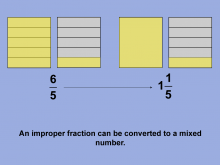
|
Math Clip Art--Fraction Concepts--Mixed Numbers 06 | Math Clip Art--Fraction Concepts--Mixed Numbers 06TopicFractions DescriptionThis image presents rectangular models for 6/5 and 1 1/5. It shows two sets of rectangles: one modeling 6/5 and the other modeling 1 1/5. This representation helps students visualize the relationship between improper fractions and mixed numbers. It demonstrates how an improper fraction like 6/5 can be expressed as a mixed number 1 1/5, showing that they represent the same quantity. Teachers can use this image to discuss the conversion between improper fractions and mixed numbers, and to reinforce the concept that mixed numbers represent quantities greater than one whole. |
Fractions and Mixed Numbers |

|
Math Clip Art--Fraction Concepts--Mixed Numbers 06 | Math Clip Art--Fraction Concepts--Mixed Numbers 06TopicFractions DescriptionThis image presents rectangular models for 6/5 and 1 1/5. It shows two sets of rectangles: one modeling 6/5 and the other modeling 1 1/5. This representation helps students visualize the relationship between improper fractions and mixed numbers. It demonstrates how an improper fraction like 6/5 can be expressed as a mixed number 1 1/5, showing that they represent the same quantity. Teachers can use this image to discuss the conversion between improper fractions and mixed numbers, and to reinforce the concept that mixed numbers represent quantities greater than one whole. |
Fractions and Mixed Numbers |

|
Math Clip Art--Fraction Concepts--Mixed Numbers 08 | Math Clip Art--Fraction Concepts--Mixed Numbers 08TopicFractions DescriptionThis image is a variation of the previous one, now showing the conversion of 12/5 to 2 2/5. It displays the step-by-step process of dividing 12 by 5 to get 2 with a remainder of 2, which then becomes the numerator of the fractional part. This representation builds on the previous example, helping students see how the process works with larger numbers. It reinforces the concept that the whole number part of a mixed number comes from how many times the denominator goes into the numerator. |
Fractions and Mixed Numbers |

|
Math Clip Art--Fraction Concepts--Mixed Numbers 01 | Math Clip Art--Fraction Concepts--Mixed Numbers 01TopicFractions DescriptionThis image serves as the title card for a series on mixed numbers. It displays the text "Mixed Numbers" in a clear, prominent font. The background may include subtle mathematical elements or fraction-related graphics to set the context for the following images in the series. This introductory image sets the stage for the subsequent images, preparing students for an exploration of mixed numbers, which combine whole numbers and fractions. It provides a clear, concise title that immediately informs viewers about the specific fraction concepts they'll be studying. |
Fractions and Mixed Numbers |

|
Math Clip Art--Fraction Concepts--Mixed Numbers 03 | Math Clip Art--Fraction Concepts--Mixed Numbers 03TopicFractions DescriptionThis image shows the graph of 1 1/4 on a number line. It displays a number line with whole numbers marked, and a point clearly indicated at 1 1/4, which would be halfway between 1 and 1 1/2. This representation helps students visualize where mixed numbers fall on a number line, reinforcing their understanding of how mixed numbers relate to whole numbers and fractions. It provides a concrete way to see that 1 1/4 is more than 1 but less than 2. Teachers can use this image to discuss how mixed numbers can be located on a number line and to reinforce the concept that mixed numbers represent values between whole numbers. |
Fractions and Mixed Numbers |

|
Math Clip Art--Fraction Concepts--Mixed Numbers 07 | Math Clip Art--Fraction Concepts--Mixed Numbers 07TopicFractions DescriptionThis image shows the numerical manipulation of 7/5 and converting it to 1 2/5. It displays the step-by-step process of dividing 7 by 5 to get 1 with a remainder of 2, which then becomes the numerator of the fractional part. This representation helps students understand the mathematical process behind converting improper fractions to mixed numbers. It provides a clear, numerical approach to complement the visual models seen in previous images. Teachers can use this image to explain the algorithm for converting improper fractions to mixed numbers and to reinforce the connection between division and fractions. |
Fractions and Mixed Numbers |

|
Math Clip Art--Fraction Concepts--Mixed Numbers 08 | Math Clip Art--Fraction Concepts--Mixed Numbers 08TopicFractions DescriptionThis image is a variation of the previous one, now showing the conversion of 12/5 to 2 2/5. It displays the step-by-step process of dividing 12 by 5 to get 2 with a remainder of 2, which then becomes the numerator of the fractional part. This representation builds on the previous example, helping students see how the process works with larger numbers. It reinforces the concept that the whole number part of a mixed number comes from how many times the denominator goes into the numerator. |
Fractions and Mixed Numbers |

|
Math Clip Art--Fraction Concepts--Mixed Numbers 10 | Math Clip Art--Fraction Concepts--Mixed Numbers 10TopicFractions DescriptionThis image shows the numerical manipulation of converting 1 2/5 to 7/5. It displays the step-by-step process of multiplying the whole number by the denominator, adding the numerator, and then writing this over the original denominator. This representation helps students understand the mathematical process behind converting mixed numbers to improper fractions. It provides a clear, numerical approach to complement the visual models seen in previous images. Teachers can use this image to explain the algorithm for converting mixed numbers to improper fractions and to reinforce the connection between multiplication and fractions. |
Fractions and Mixed Numbers |

|
Math Clip Art--Fraction Concepts--Proper and Improper Fractions 07 | Math Clip Art--Fraction Concepts--Proper and Improper Fractions 07TopicFractions DescriptionThis image shows another variation with these fractions: 1/4, 3/8, 5/12, and 15/16, emphasizing that proper fractions are less than 1. It displays visual models for each fraction, clearly showing that the shaded portion is less than the whole in each case. This representation further reinforces the concept of proper fractions, showing examples with increasingly larger denominators. It helps students understand that even as fractions get closer to 1, they remain proper fractions as long as the numerator is less than the denominator. |
Identify and Name Fractions |
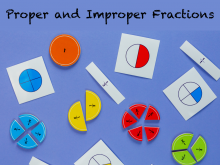
|
Math Clip Art--Fraction Concepts--Proper and Improper Fractions 01 | Math Clip Art--Fraction Concepts--Proper and Improper Fractions 01TopicFractions DescriptionThis image serves as the title card for a series on proper and improper fractions. It displays the text "Proper and Improper Fractions" in a clear, prominent font. The background may include subtle mathematical elements or fraction-related graphics to set the context for the following images in the series. This introductory image sets the stage for the subsequent images, preparing students for an exploration of the differences between proper and improper fractions. It provides a clear, concise title that immediately informs viewers about the specific fraction concepts they'll be studying. |
Identify and Name Fractions |
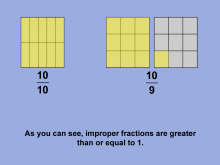
|
Math Clip Art--Fraction Concepts--Proper and Improper Fractions 10 | Math Clip Art--Fraction Concepts--Proper and Improper Fractions 10TopicFractions DescriptionThis image is a variation of the previous one, now showing visual models for 10/10 and 10/9. It displays rectangular visual representations: one divided into 10 parts with all 10 parts shaded, and another pair of rectangles divided into 9 parts with 10 parts shaded. This representation helps students understand that improper fractions include fractions equal to one whole (like 10/10) as well as those greater than one whole (like 10/9). It reinforces the concept that improper fractions have numerators greater than or equal to their denominators. |
Identify and Name Fractions |
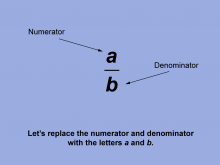
|
Math Clip Art--Fraction Concepts--Proper and Improper Fractions 03 | Math Clip Art--Fraction Concepts--Proper and Improper Fractions 03TopicFractions DescriptionThis image shows a/b for any whole number a and b, with b not equal to zero. It displays the fraction a/b with labels or explanations indicating that a and b can be any whole numbers, but b cannot be zero. This representation introduces students to the general form of a fraction and the important rule that the denominator cannot be zero. It helps students understand that fractions can represent a wide range of values and prepares them for working with variables in algebraic fractions. |
Identify and Name Fractions |
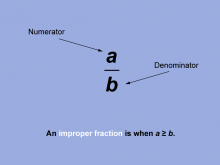
|
Math Clip Art--Fraction Concepts--Proper and Improper Fractions 08 | Math Clip Art--Fraction Concepts--Proper and Improper Fractions 08TopicFractions DescriptionThis image introduces the concept of improper fractions, stating that a fraction a/b is improper if a is greater than or equal to b. It displays the fraction a/b with a visual or textual explanation indicating that when the numerator is greater than or equal to the denominator, the fraction is improper. This representation helps students understand the definition of improper fractions and how they differ from proper fractions. It sets the stage for exploring fractions that represent one whole or more than one whole. |
Identify and Name Fractions |
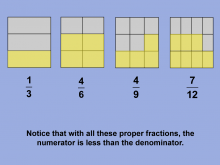
|
Math Clip Art--Fraction Concepts--Proper and Improper Fractions 06 | Math Clip Art--Fraction Concepts--Proper and Improper Fractions 06TopicFractions DescriptionThis image presents a variation of the previous concept, now using rectangular models to show proper fractions: 1/3, 4/6, 4/9, and 7/12. It displays four rectangles, each divided into the appropriate number of sections with the corresponding number of sections shaded to represent each fraction. |
Identify and Name Fractions |

|
Math Clip Art--Fraction Concepts--Proper and Improper Fractions 04 | Math Clip Art--Fraction Concepts--Proper and Improper Fractions 04TopicFractions DescriptionThis image is a variation of the previous one, now showing that for a proper fraction, a < b. It displays the fraction a/b again, but with an additional note or visual indicator that the numerator (a) is less than the denominator (b). This representation introduces the concept of proper fractions, helping students understand that when the numerator is less than the denominator, the fraction represents a part of a whole that is less than one. |
Identify and Name Fractions |
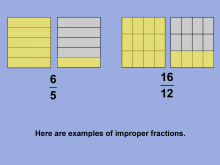
|
Math Clip Art--Fraction Concepts--Proper and Improper Fractions 09 | Math Clip Art--Fraction Concepts--Proper and Improper Fractions 09TopicFractions DescriptionThis image provides visual models of improper fractions using rectangular models for 6/5 and 16/12. It shows two rectangles: one divided into 5 parts with 6 parts shaded (extending beyond the original rectangle), and another divided into 12 parts with 16 parts shaded. This representation helps students visualize improper fractions and understand that they represent more than one whole. It demonstrates how improper fractions can be represented visually, even when they exceed one complete unit. |
Identify and Name Fractions |

|
Math Clip Art--Fraction Concepts--Proper and Improper Fractions 02 | Math Clip Art--Fraction Concepts--Proper and Improper Fractions 02TopicFractions DescriptionThis image shows 1/4 with labels for numerator and denominator. It displays the fraction 1/4 with the number 1 clearly labeled as the numerator and the number 4 labeled as the denominator. This representation helps students understand the basic structure of a fraction, identifying the roles of the numerator and denominator. It reinforces the concept that the numerator represents the number of parts being considered, while the denominator represents the total number of equal parts the whole is divided into. |
Identify and Name Fractions |
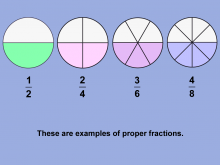
|
Math Clip Art--Fraction Concepts--Proper and Improper Fractions 05 | Math Clip Art--Fraction Concepts--Proper and Improper Fractions 05TopicFractions DescriptionThis image provides examples of proper fractions shown as circular fractions: 1/2, 2/4, 3/6, and 4/8. It displays four circles, each divided into the appropriate number of sections with the corresponding number of sections shaded to represent each fraction. This visual representation helps students see that these fractions, while written differently, all represent proper fractions (less than one whole). It reinforces the concept of proper fractions and introduces the idea of equivalent fractions. |
Identify and Name Fractions |
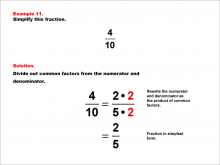
|
Math Example--Fraction Properties--Simplifying Fractions--Example 11 | Simplifying Fractions--Example 11TopicFractions DescriptionThis example demonstrates simplifying the fraction 4/10 by finding the greatest common divisor (GCD), which is 2. The simplified form is 2/5. This teaches students about recognizing common factors and reducing fractions to their simplest form. For a complete collection of math examples related to Simplifying Fractions click on this link: Math Examples: Simplifying Fractions Collection. |
Write Fractions in Lowest Terms |
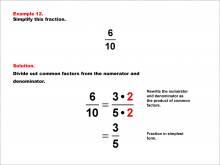
|
Math Example--Fraction Properties--Simplifying Fractions--Example 12 | Math Example--Fraction Properties--Simplifying Fractions--Example 12TopicFractions DescriptionThis example demonstrates simplifying the fraction 6/10 by finding the GCD, which is 2. The simplified form is 3/5. This teaches students about recognizing common factors and reducing fractions to their simplest form. For a complete collection of math examples related to Simplifying Fractions click on this link: Math Examples: Simplifying Fractions Collection. |
Write Fractions in Lowest Terms |
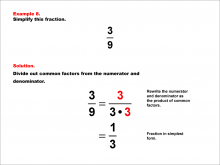
|
Math Example--Fraction Properties--Simplifying Fractions--Example 8 | Simplifying Fractions--Example 8TopicFractions DescriptionHere, the fraction 3/9 is presented. Students are encouraged to find the GCD, noted as 3, allowing them to reduce to 1/3, showcasing critical skills in fraction simplification and equivalent identification. For a complete collection of math examples related to Simplifying Fractions click on this link: Math Examples: Simplifying Fractions Collection. |
Write Fractions in Lowest Terms |

|
Math Example--Fraction Properties--Simplifying Fractions--Example 13 | Simplifying Fractions--Example 13TopicFractions DescriptionThis example demonstrates simplifying the fraction 8/10 by finding the GCD, which is 2. The simplified form is 4/5. This teaches students about recognizing common factors and reducing fractions to their simplest form. For a complete collection of math examples related to Simplifying Fractions click on this link: Math Examples: Simplifying Fractions Collection. |
Write Fractions in Lowest Terms |
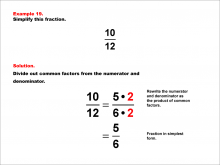
|
Math Example--Fraction Properties--Simplifying Fractions--Example 19 | Simplifying Fractions--Example 19TopicFractions DescriptionThis example demonstrates simplifying the fraction 10/12 by finding the GCD, which is 2. The simplified form is 5/6. This teaches students about recognizing common factors and reducing fractions to their simplest form. For a complete collection of math examples related to Simplifying Fractions click on this link: Math Examples: Simplifying Fractions Collection. |
Write Fractions in Lowest Terms |
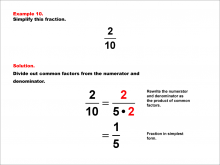
|
Math Example--Fraction Properties--Simplifying Fractions--Example 10 | Simplifying Fractions--Example 10TopicFractions DescriptionThis example focuses on simplifying the fraction 2/10. By finding the GCD, which is 2, students simplify the fraction to 1/5. This activity reinforces their skills in recognizing common factors and understanding equivalent fractions. For a complete collection of math examples related to Simplifying Fractions click on this link: Math Examples: Simplifying Fractions Collection. |
Write Fractions in Lowest Terms |